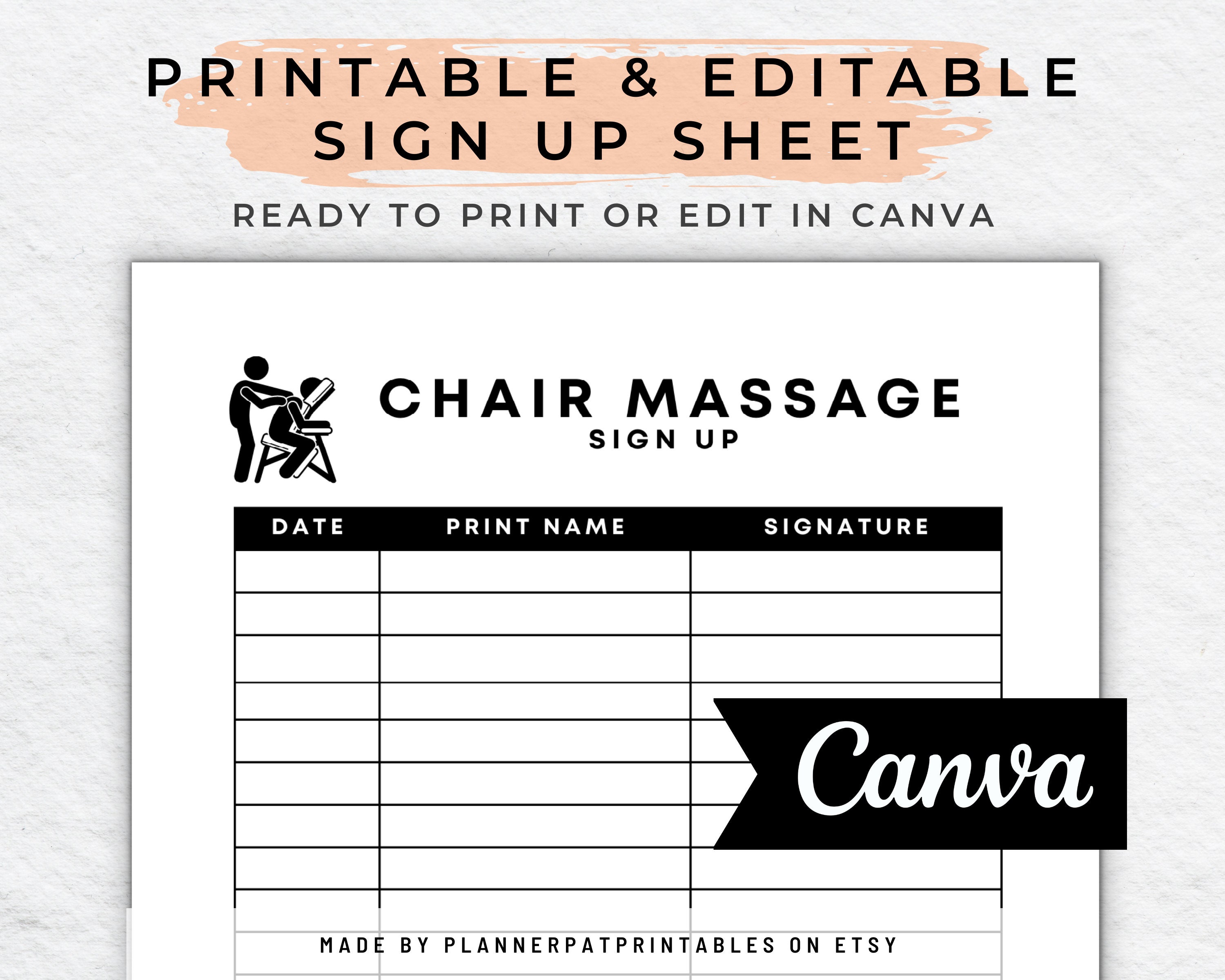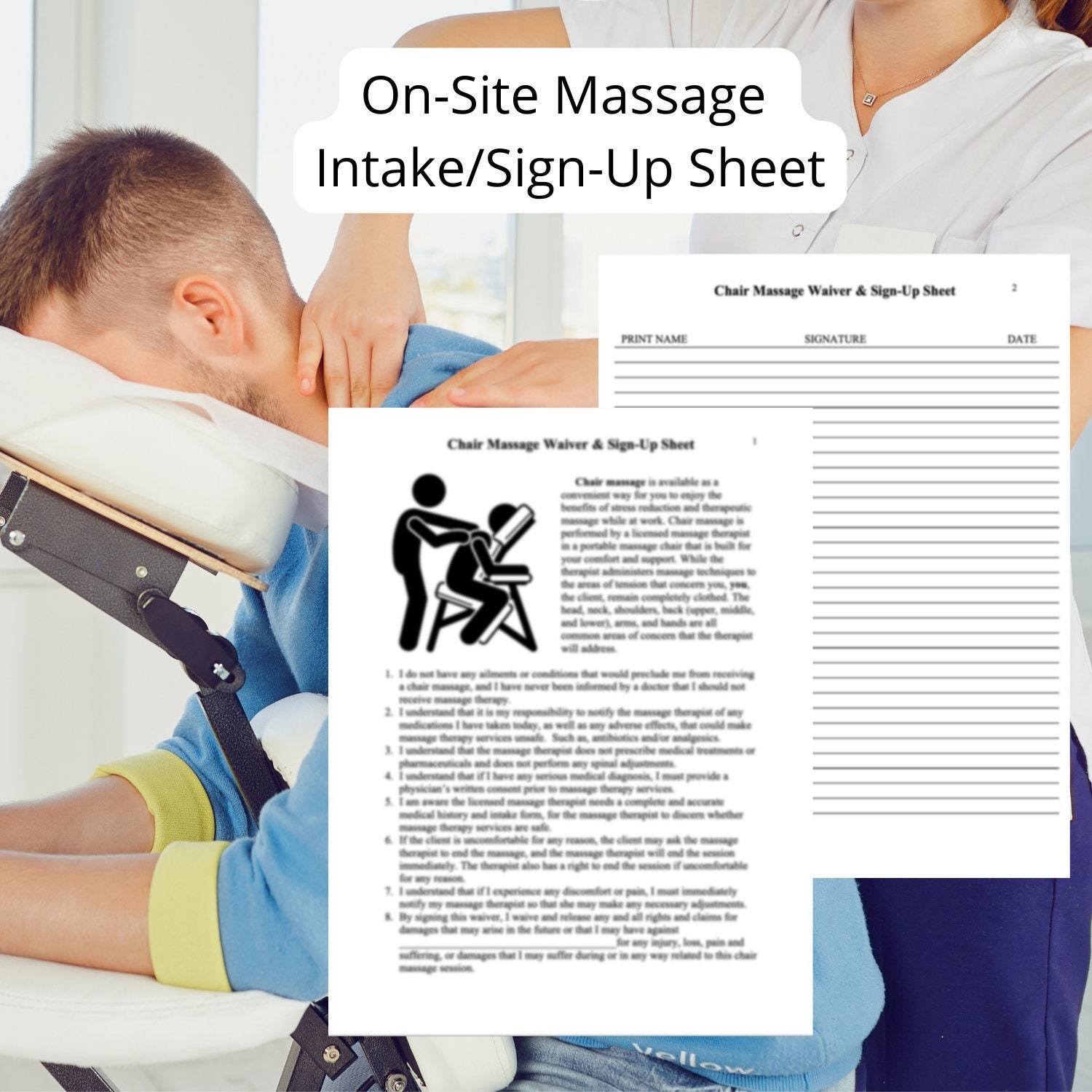Understanding Chair Massage Liability Waivers

Chair massage liability waivers are crucial documents that protect both the massage therapist and the client. They Artikel the risks associated with chair massage and ensure that clients are aware of their responsibilities and limitations.
Purpose of a Chair Massage Liability Waiver
A chair massage liability waiver serves several important purposes:
- Informs Clients of Risks: The waiver clearly Artikels the potential risks associated with chair massage, including but not limited to muscle strain, discomfort, and potential aggravation of pre-existing conditions. This transparency ensures clients are fully aware of the potential outcomes before receiving the massage.
- Protects Massage Therapists: The waiver serves as a legal document that protects massage therapists from liability for any unforeseen injuries or complications that may arise during the massage session. It acknowledges that the client has been informed of the risks and has voluntarily chosen to proceed with the massage.
- Establishes Clear Expectations: By signing the waiver, clients acknowledge that they understand the nature of the service, the risks involved, and the limitations of the massage. This establishes clear expectations for both parties, minimizing the potential for misunderstandings or disputes.
Key Elements of a Comprehensive Waiver
A comprehensive chair massage liability waiver should include the following essential elements:
- Clear and Concise Language: The waiver should be written in plain language that is easy to understand for all clients, regardless of their educational background or legal expertise. Avoid using technical jargon or overly complex legal terminology.
- Detailed Description of Risks: The waiver should clearly Artikel the potential risks associated with chair massage, including muscle strain, discomfort, aggravation of pre-existing conditions, and other potential complications. It should also specify any contraindications, such as pregnancy or recent injuries, that may make chair massage unsuitable.
- Client Responsibilities: The waiver should clearly state the client’s responsibilities, such as providing accurate medical history, informing the massage therapist of any relevant medical conditions, and adhering to the massage therapist’s instructions. It should also emphasize the client’s responsibility for their own safety and well-being during the massage session.
- Release of Liability: The waiver should explicitly state that the client releases the massage therapist and their business from any liability for injuries or complications that may arise during the massage session, as long as the massage therapist has acted with reasonable care and skill. This provision protects the massage therapist from potential legal claims.
- Acknowledgement of Consent: The waiver should include a statement that the client has read and understood the contents of the waiver and has voluntarily chosen to proceed with the massage. This acknowledgment ensures that the client has made an informed decision and has not been coerced into signing the waiver.
- Signatures and Dates: The waiver should be signed and dated by both the client and the massage therapist. This provides legal evidence of the client’s agreement to the terms of the waiver.
Legal Implications of a Chair Massage Liability Waiver
A chair massage liability waiver is a legally binding document that can protect both the massage therapist and the client. However, the effectiveness of the waiver depends on several factors:
- Clarity and Comprehensiveness: A well-written and comprehensive waiver that clearly Artikels the risks, responsibilities, and limitations of chair massage is more likely to be upheld in court.
- State Laws and Regulations: The legal implications of a chair massage liability waiver may vary depending on the specific state laws and regulations governing massage therapy. It is essential for massage therapists to consult with an attorney to ensure that their waiver complies with all applicable laws.
- Circumstances of Injury: If a client suffers an injury during a chair massage, the court will consider the circumstances surrounding the injury, the actions of the massage therapist, and the client’s compliance with the terms of the waiver. A well-documented massage session, including a detailed client intake form and clear communication of the risks, can strengthen the massage therapist’s legal position.
Common Risks and Liabilities in Chair Massage

Chair massage, while generally considered a safe and relaxing experience, does carry inherent risks and potential liabilities. Understanding these risks is crucial for both massage therapists and clients to ensure a safe and enjoyable session.
Potential Risks Associated with Chair Massage
Potential risks associated with chair massage are generally related to the unique posture and pressure applied during the session. While most chair massage sessions are safe, it is important to be aware of potential risks to ensure a safe and enjoyable experience for both the therapist and the client.
- Muscle Strain and Injury: Inappropriately applied pressure or techniques can lead to muscle strain, sprains, or even tears. This is particularly true for individuals with pre-existing conditions or those who are new to massage therapy.
- Joint Pain and Discomfort: The seated position can put stress on joints, especially in the neck, shoulders, and back. Inexperienced therapists may not be aware of proper joint positioning and could inadvertently cause discomfort or pain.
- Circulatory Issues: Certain massage techniques, particularly those involving deep pressure, can temporarily restrict blood flow. This is a concern for individuals with pre-existing circulatory conditions or those taking blood thinners.
- Dizziness and Fainting: Some individuals may experience dizziness or faintness during or after a chair massage, especially if they are dehydrated or have low blood pressure.
Liability Issues in Chair Massage
Liability issues in chair massage can arise from a variety of factors, including negligence, improper technique, and lack of informed consent.
- Negligence: If a therapist fails to provide a reasonable standard of care, resulting in injury to the client, they could be held liable for negligence. This includes failing to obtain informed consent, not adequately assessing the client’s health history, or using inappropriate techniques.
- Improper Technique: Using improper massage techniques or applying excessive pressure can lead to injuries and potential liability. Therapists must be properly trained and licensed to ensure they are using safe and effective techniques.
- Lack of Informed Consent: It is crucial for therapists to obtain informed consent from clients before starting a massage session. This involves discussing potential risks, benefits, and limitations of the treatment. Failing to obtain informed consent can lead to liability if a client experiences an adverse reaction.
Potential Injuries During Chair Massage
Potential injuries during chair massage can range from minor discomfort to serious injuries. Understanding these potential injuries can help both therapists and clients take necessary precautions.
- Soft Tissue Injuries: These include muscle strains, sprains, and tears. They are often caused by improper pressure or techniques, and can range from mild discomfort to severe pain and limitations in movement.
- Joint Injuries: These can involve sprains, dislocations, or even fractures. They are more likely to occur in individuals with pre-existing joint conditions or if the therapist applies excessive pressure to a joint.
- Nerve Damage: While less common, nerve damage is possible if the therapist applies pressure to a nerve or uses techniques that are too vigorous. This can lead to numbness, tingling, or weakness in the affected area.
- Circulatory Issues: These can include blood clots, deep vein thrombosis, or even stroke. They are more likely to occur in individuals with pre-existing circulatory conditions or if the therapist applies pressure to the wrong areas.
Best Practices for Chair Massage Businesses: Chair Massage Liability Waiver

Chair massage businesses, like any other healthcare or wellness service provider, must prioritize the safety and well-being of both their therapists and clients. Implementing best practices is essential to ensure a positive experience for everyone involved and minimize potential risks.
Proper Screening and Client Assessment
Thorough screening and client assessment are crucial for chair massage businesses. This helps identify potential risks and ensure appropriate care is provided.
- Health History Review: Before the massage, therapists should review client health history forms, asking specific questions about conditions like pregnancy, recent injuries, and any medications they are taking. This allows therapists to modify techniques or decline services if necessary.
- Physical Assessment: A brief physical assessment is essential to identify any limitations or contraindications. This may involve checking for range of motion, muscle tension, or any visible signs of injury.
- Communication: Open and honest communication with clients is key. Therapists should explain the massage process, potential risks, and any limitations they may have. Clients should feel comfortable asking questions and expressing any concerns.
Safety Practices for Therapists and Clients, Chair massage liability waiver
Maintaining a safe environment for both therapists and clients is paramount.
- Ergonomics: Therapists should use proper body mechanics and posture to avoid strain and injury. This includes using adjustable chairs, maintaining a neutral spine, and taking breaks to stretch and move around.
- Hygiene and Sanitation: Maintaining a clean and hygienic environment is crucial. Therapists should wash their hands before and after each massage, use clean linens, and sanitize equipment regularly.
- Emergency Procedures: Every chair massage business should have a clear emergency plan in place, including protocols for handling allergic reactions, fainting, or other medical emergencies. Therapists should be trained in basic first aid and CPR.
Handling Potential Incidents or Injuries
While every effort should be made to prevent incidents, it is important to have a clear plan for handling potential injuries or complaints.
- Immediate Action: If an incident occurs, the therapist should prioritize the client’s safety and well-being. They should immediately assess the situation and provide any necessary first aid.
- Documentation: Thorough documentation is essential. Therapists should record details of the incident, including the client’s symptoms, any actions taken, and the date and time. This documentation can be used for insurance purposes and to track potential trends.
- Communication: The business owner should be informed of the incident promptly. They should contact the client to express concern and offer any necessary support. Depending on the severity of the incident, it may be necessary to contact emergency services or a medical professional.
- Follow-Up: After the incident, the business should follow up with the client to ensure they are recovering well. They should also review the incident to identify any potential contributing factors and implement corrective measures to prevent similar incidents in the future.
Chair massage liability waivers are a prime example of how corporations prioritize profits over people’s well-being. They’re designed to protect businesses from any potential liability, even if it means sacrificing the health and safety of their customers. While the convenience of a quick chair massage in Milwaukee, WI, might seem appealing, chair massage milwaukee wi is not without its risks.
These waivers often include clauses that absolve the company from responsibility for injuries, even if they are caused by negligence. This practice highlights the need for greater consumer protection and a more equitable balance of power between businesses and individuals.
The fine print of a chair massage liability waiver often conveniently overlooks the potential for malfunctioning equipment, conveniently shifting the burden of responsibility onto the client. But what happens when the chair itself becomes the culprit? For those unfortunate enough to own a Berkline massage chair, finding replacement parts can be a frustrating and expensive endeavor, as evidenced by the detailed guide on berkline massage chair parts.
The lack of accessible, affordable repair options only reinforces the inherent power imbalance in the massage industry, leaving clients vulnerable to potential injury and financial hardship.